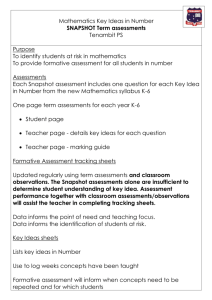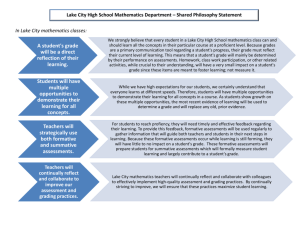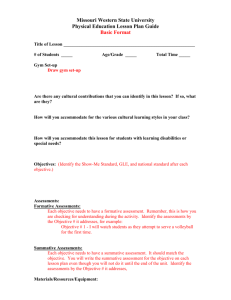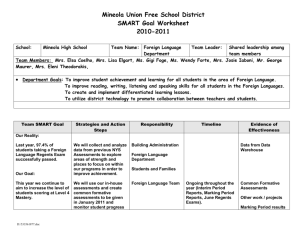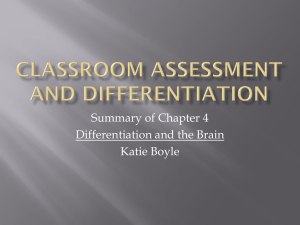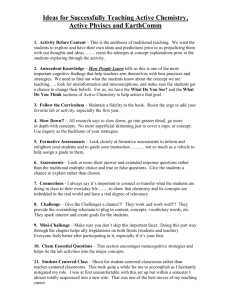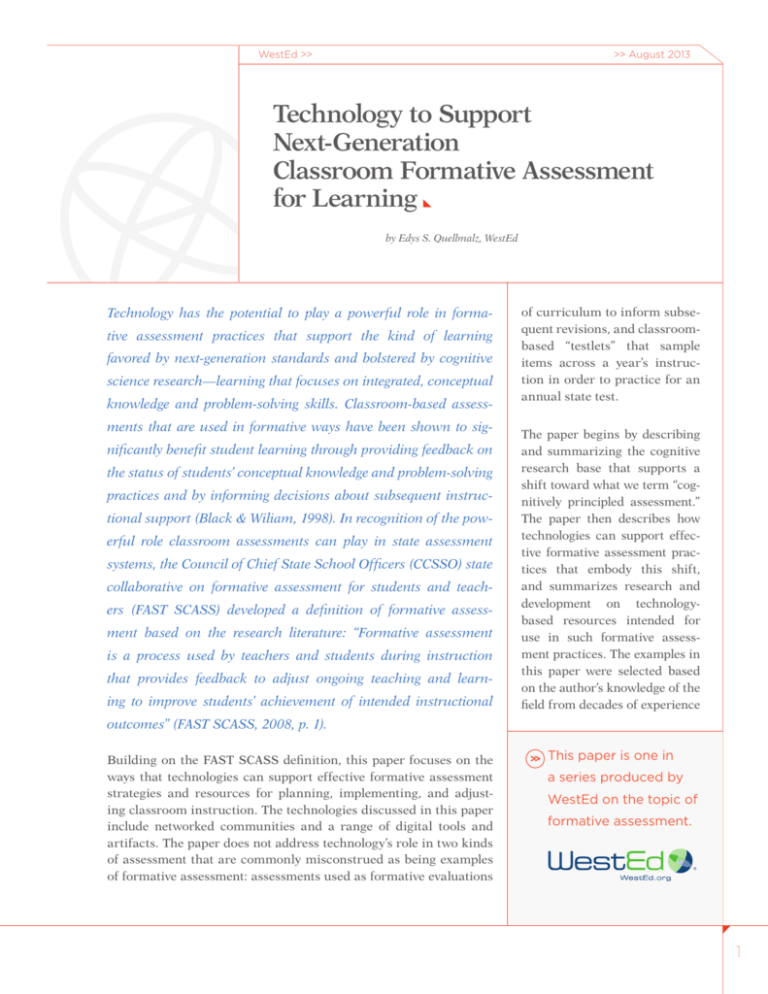
WestEd >>
>> August 2013
Technology to Support
Next-Generation
Classroom Formative Assessment
for Learning
by Edys S. Quellmalz, WestEd
Technology has the potential to play a powerful role in formative assessment practices that support the kind of learning
favored by next-generation standards and bolstered by cognitive
­science research—learning that focuses on integrated, conceptual
­knowledge and problem-solving skills. Classroom-based assessments that are used in formative ways have been shown to significantly benefit student learning through providing feedback on
the status of students’ conceptual knowledge and problem-solving
practices and by informing decisions about subsequent instructional support (Black & Wiliam, 1998). In recognition of the powerful role classroom assessments can play in state assessment
systems, the Council of Chief State School Officers (CCSSO) state
collaborative on formative assessment for students and teachers (FAST SCASS) developed a definition of formative assessment based on the research literature: “Formative assessment
is a p
­ rocess used by teachers and students during instruction
that provides feedback to adjust ongoing teaching and learning to improve students’ achievement of intended instructional
of curriculum to inform subsequent revisions, and classroombased “testlets” that sample
items across a year’s instruction in order to practice for an
annual state test.
The paper begins by describing
and summarizing the cognitive
research base that supports a
shift toward what we term “cognitively principled assessment.”
The paper then describes how
technologies can support effective formative assessment practices that embody this shift,
and summarizes research and
development on technologybased resources intended for
use in such formative assessment practices. The examples in
this paper were selected based
on the author’s knowledge of the
field from decades of experience
­outcomes” (FAST SCASS, 2008, p. 1).
Building on the FAST SCASS definition, this paper focuses on the
ways that technologies can support effective formative assessment
strategies and resources for planning, implementing, and adjusting classroom instruction. The technologies discussed in this paper
include networked communities and a range of digital tools and
artifacts. The paper does not address technology’s role in two kinds
of assessment that are commonly misconstrued as being examples
of formative assessment: assessments used as formative evaluations
This paper is one in
a series produced by
WestEd on the topic of
formative assessment.
1
WestEd >>
The NRC report, Knowing What Students Know,
Application of … a systematic process of
cognitively principled assessment design
brings together decades of research in cognition,
measurement, and psychometrics to make recommendations for learning-based assessments
can help ensure the quality and validity
(Pellegrino, Chudowsky, & Glaser, 2001). The
of formative assessments developed by
learning research and national frameworks and
programs and teachers.
standards provide the cognitive component of cognitively principled assessment design.
Evidence-centered assessment design forms the
in research, development, and evaluation projects
related to technology-based student learning environments and assessments. The paper also presents
a vignette to illustrate some of the ways teachers can
take advantage of technology to plan, implement,
and refine their formative assessment strategies.
measurement component of cognitively principled
assessment design. Evidence-centered assessment
design involves linking the learning to be assessed
(a student model), to a task model that specifies features of the tasks and questions that would elicit the
evidence of learning, then to an evidence model that
specifies the types of student responses and scores
Cognitively principled assessment design
that would indicate levels of proficiency (Messick,
1994; Mislevy, Almond, & Lukas, 2003; Pellegrino
et al., 2001).
Research on learning and on assessment should
inform the development of assessments to measure
learning progress and inform instructional decisions. For example, research on the development
of expertise, as summarized in publications such
as the National Research Council (NRC) report,
How People Learn, indicates that experts build
large, organized, interconnected knowledge structures and problem-solving strategies in a domain
(Bransford, Brown, & Cocking, 2000). For the
domain of science, national standards documents
such as the Framework for Science Education and
the Next Generation Science Standards recommend that science educators focus on fewer, more
integrated, core disciplinary ideas. Such a focus
on deeper learning will avoid previous standards’
more shallow coverage of a large number of topics and will allow more time to engage in scientific investigations and argumentation (National
Research Council, 2011, 2012). These current standards call for assessments of integrated knowledge
and extended reasoning and problem solving, in
contrast to the disconnected facts and procedures
so prevalent in traditional assessments.
2
Cognitively principled assessment design, therefore, combines specification of the core disciplinary principles and problem-solving strategies that
are the goals of instruction and assessment with
the systematic design of assessments that link the
learning targets with the assessment tasks and
questions and the ways student responses will be
scored and reported as evidence of achievement.
National standards lay out the broad disciplinary core ideas and processes deemed by the professions to be goals of K–12 education (National
Research Council, 2011, 2012; Common Core State
Standards Initiative, 2010a, 2010b). Once the cognitive student models for learning targets have
been specified, task models for activities and questions allowing observations of the learning, and
evidence models for appraising the learning can
complete the assessment design. Application of
such a systematic process of cognitively principled
assessment design can help ensure the quality and
validity of formative assessments developed by programs and teachers.
>> August 2013
Effective formative assessment
Formative assessment practices include not only
a variety of informal strategies teachers may use
“on the fly,” but also formal, structured assessment tasks and methods that are systematically
designed to help teachers probe and promote student thinking and reasoning. The cognitively principled design processes described above can guide
development or selection of assessments to embed
in instruction. Such cognitively principled assessment designs are greatly needed to counter the
uneven technical quality of classroom assessments
developed by teachers or assessments included with
published curriculum materials (Wilson & Sloane,
2000; Mislevy & Haertel, 2006).
Formative assessment strategies are, by definition,
planned by teachers prior to instruction. Research
has found that the following features are components of effective formative assessment: (1) specification of and alignment with valued content
standards that range from core principles and practices to basic knowledge and skills; (2) monitoring
of progressive development; (3) realistic, challenging problems and items that elicit students’ understanding and make their understanding visible;
(4) feedback on student learning during instruction
that identifies areas in need of improvement; and
(5) guidance for teachers to modify instruction to
meet student needs (Herman et al., 2005). Drawing
on such research, the attributes of effective formative assessment strategies proposed by the FAST
SCASS (2008) include:
1.Learning progressions—Assessments are designed to show where students are located on
explicit pathways of increasing knowledge and
skills (Heritage, 2008).
2.Learning goals—Goals and criteria for success
are clear and communicated to students.
3.Embedded assessment—During instruction,
evidence is gathered on learning progress and
­action is taken.
4.Specific feedback—Feedback based on assessment evidence describes to students where they
are going, where their learning currently falls
(on a progression), and what they can do to move
ahead and close the gap.
5.Collaboration—Teachers and students work together to monitor learning and modify instruction.
6.Self and peer assessment—Students are actively
engaged in assessment themselves.
Within the framework of cognitively principled
assessment design, specification of the learning
progressions and goals for instruction would be
the first step, drawn from standards based on
cognitive learning research. Assessment targets
would further specify the knowledge and processes to be measured during instruction. Then,
embedded assessments and feedback would be
planned to elicit evidence of the learning during
instruction. These embedded assessments could
be activities and questions planned by the teacher
or selected from existing resources. Feedback and
further action in the form of immediate coaching or subsequent adjusted instruction could be
provided by both the teacher and by interactive
technologies. The planned assessments would
also include activities that engaged students in
self‑assessment and collaboration with other students and the teacher.
Technology supports for alignment of
embedded assessments with standards
and targets
Development of cognitively principled assessments
to embed in instruction places a heavy demand
on teachers. Planning for embedding assessments
during instruction and for providing feedback
and differentiated follow-up requires not only
time, but also pedagogical content knowledge
and assessment expertise. Technology can support teachers’ ability to build effective formative
assessment features into their classroom practice.
Technology-based resources can help teachers
Technology to Support Next-Generation Classroom Formative Assessment for Learning
WestEd >>
3
WestEd >>
Curriculum alignments should be
screened to ensure that they do not
emphasize simple facts and procedures at
the expense of challenging reasoning and
problem solving.
overcome many of the design and practical limitations of implementing classroom-based formative assessment practices because technology can
make available cognitively principled assessment
tasks to embed in curricula so that teachers do not
have to rely on developing such tasks themselves.
Moreover, technology can help to align, design,
deliver, score, and interpret assessments within
rich task environments that measure deep understandings in a feasible and cost-effective manner
(Quellmalz & Haertel, 2004).
Online alignment and search tools
For teachers to plan assessments that will be
embedded in their instruction and will focus on
specific intended outcomes aligned with district,
state, and national standards, the formative assessment process needs to begin with alignment of unit
and lesson goals with those standards. Technology
can facilitate such alignment activities by offering online databases that link curriculum, district,
state, and national standards. Curriculum programs may provide “cross walks” of their curriculum-specific instructional activities to standards.
The caveat for such publisher-provided alignment
and search tools is that they may not be framed
within the larger picture of the core disciplinary
ideas or learning progressions. Curriculum alignments should be screened to ensure that they do
not emphasize simple facts and procedures at the
expense of challenging reasoning and problem
solving. For example, teachers should be looking
for assessments that gauge whether students can
determine the flow of energy and matter through an
4
ecosystem, rather than if students can just identify
a producer and consumer.
Online alignment tools can provide training
for judging the alignment of existing assess­
ment tasks and items with standards. Such
alignment tools could support efforts by
groups of teachers to align standards, cur­
ricula, and assessments. Both Common Core
state assessment consortia describe plans for
helping teachers to align assessments with the
Common Core standards (see, for ­example, http://
parcconline.org/non-summative-assessments and
http://www.smarter­balanced.org/k-12-education/
teachers/).
However, teachers need to plan to embed assessment questions, tasks, and items that align not
just with broad standards but with a progression
of more specific learning targets that build in complexity within lessons and across a unit. To date,
there are few research-based learning progressions
at the lesson and unit level for teachers to access
for unit planning (Trumbull & Lash, 2013, pp. 6–7).
More commonly, standards become queries for
searching for assessments that have been aligned
by others to those standards. For example, the
Performance Assessment Links in Science (PALS)
and Performance Assessment Links in Math (PALM)
relational databases, funded by the National Science
Foundation, offer tools to support searching online
databases of science or math performance assessments aligned with national and state standards or
curriculum units (SRI International, 2002, 2005).
Assessment collections
A key resource that technology can make available
to teachers is access to pools of assessment tasks and
items that teachers can embed within lessons and
units. The resources can vary widely in their quality, such as whether they come with documentation
of their basis in learning and assessment research
for diagnosing deep content understanding and
problem solving or with documentation of their
technical quality. Curriculum and test publishers
may provide sets of diagnostic assessments online
>> August 2013
WestEd >>
To date, these products tend to offer easy-to-administer, easy-to-score multiple-choice questions and
some constructed-response ones. Teachers may be
able to select individual tasks or sets of tasks and
items that may be downloadable to print or be technology-delivered. Some embedded assessments also
offer differentiated follow-up instructional activities. Few collections have any documentation of
their technical quality and tend toward testing simple concepts and skills. An exception is the science
item bank developed by the American Association
for the Advancement of Science (1993). Sets of
items represent progressive sequences of conceptual development, along with prerequisite knowledge. Data on the psychometric technical quality
of the items are included (American Association for
the Advancement of Science, n.d.). The Council of
Chief State School Officers has developed a bank
of conventional science items and performance
assessments along with technical quality data for
them (CCSSO, 2012). The PALS and PALM performance assessment collections post technical quality data provided by the assessment developers (SRI
International, 2002, 2005).
Formative assessments designed
by teachers
Software to help teachers develop assessment
items has been created by multiple agencies.
These software programs contain item templates
and may have ancillary resources associated with
The resources can vary widely in their
quality, such as whether they come with
documentation of their basis in learning
and assessment research for diagnosing
deep content understanding and problem
solving or with documentation of their
technical quality.
them, such as libraries of mathematical and scientific notations, graphics, maps, and other supports
that are not available with generic word processing
tools. North Carolina and other states provide templates for teachers to use in constructing tests with
traditional item formats (for example, see http://
www.ixl.com/standards/north-carolina/math).
Such templates can support the generation of individual items, such as multiple-choice items with a
closed format, or more elaborate assessment tasks
that involve a student completing several sequenced
tasks, and the scoring rubrics that accompany the
items and tasks. The Global Learning Observations
for a Better Environment (GLOBE) assessment
templates are such a resource for teachers to use
in constructing performance assessments (GLOBE
Program, 2002; SRI International, 2005). On the
GLOBE assessment website, which is also linked
to the PALS site, the template presents a form that
teachers can use to develop performance assessments in which students solve real-world problems by using GLOBE data. The template provides
cues for inserting GLOBE visualizations and
data displays, an applied environmental problem
to which the data are relevant, and sequences of
“stem questions” as starters for questions related
to the GLOBE assessment investigation framework. Another project, the Formative Assessment
Delivery System (FADS) provides online templates
and resources such as graphing and table tools for
teachers to create their own classroom assessments
(Scalise et al., 2010).
Technology to Support Next-Generation Classroom Formative Assessment for Learning
or off-line that fit in their curriculum materials or
are keyed to standards to be assessed on the annual
state test. Some states, such as North Carolina, are
using item bank software (for more information,
see http://www.ixl.com/standards/north-carolina/).
Publishers have created an array of computer-based
test products for low-stakes assessments that incorporate banks of items, largely in the multiple-choice
format. These item banks can be custom linked to
a state’s standards. Teachers can search the item
banks to assemble tests and quizzes customized to
their curriculum and state standards.
5
WestEd >>
A goal … is for technology to enable
assessment of those aspects of cognition
and performance that are complex
and dynamic and that were previously
impossible to assess directly.
To date, the state assessment consortia are in the
early stage of developing supports for formative
assessment related to the Common Core standards.
The Partnership for Assessment of Readiness for
College and Careers (PARCC) is developing strategies
for formative assessment (for more information, see
http://parcconline.org/non-summative-assessments),
and the Smarter Balanced Assessment Consortium
is funding development of a digital library that will
help states implement effective formative assessment
strategies. A set of quality standards will guide
screening of formative
assessment resources to
be made available in the Smarter Balanced library.
The consortium is developing professional learning
materials on assessment literacy and educational
resources that will include exemplar instructional
models that embed formative assessment (http://
w w w. s m a r t e r b a l a n c e d .o r g / k-­12 - e du c at io n /­
teachers/). State networks of educators will provide
feedback on the development and dissemination
of resources and tools and recommend additional
resources for the library.
Technology-enhanced,
curriculum-embedded assessments
A new generation of assessments is moving
beyond the use of technology only for resource
collections or for test assembly, delivery, and
scoring of conventional item formats. A goal of
these new assessments is for technology to enable
assessment of those aspects of cognition and performance that are complex and dynamic and that
were previously impossible to assess directly. For
6
English/Language Arts and 21st-century skills,
technology-based assessments can capture the
process and depth of students’ comprehension,
as well as gauge their research skills involving
internet searches, evaluation of sources, and use
of multimedia to access, analyze, and communicate (Quellmalz & Kozma, 2003). In mathematics,
the sequences that students follow to solve problems can be traced. In science, digital technologies can represent dynamic causal, temporal, and
spatial phenomena, giving students opportunities to deploy active inquiry practices. The technology-based, next-generation assessments are
characterized by rich, complex, authentic contexts; interactive, dynamic responses; individualized feedback and coaching; diagnostic progress
reporting; and links to supplemental instructional resources (Quellmalz, Timms, Buckley
et al., 2012).
One example of such next-generation assessments
is the set of simulation-based, curriculum-embedded science assessments developed by WestEd’s
SimScientists program (SimScientists, 2013). The
SimScientists assessments are intended to function
as resources for formative assessment practices by:
(1) aligning with science system model progressions and science inquiry practices; (2) presenting
dynamic, interactive simulation environments that
support active inquiry investigations; (3) providing
intelligent tutoring that gives immediate feedback
contingent on an individual student’s performance;
(4) offering graduated levels of coaching in real
time; (5) supporting self-assessment of explanations;
and (6) providing diagnostic information to guide
a teacher’s assignment of off-line reflection and
extension activities. The SimScientists assessments
are coupled with follow-up, off-line self‑assessment
and reflection activities. The curriculum-embedded
assessment and reflection activities incorporate features of effective formative assessment: frequent use
of standards-based classroom assessments; feedback that is timely, individualized, and diagnostic;
online supplementary instruction that is individualized; and self‑assessment and reflection activities
that help students confront misunderstandings,
>> August 2013
make new connections, and become more reflective, self-regulating learners (Herman et al., 2005).
The SimScientists technology includes a Learning
Management System that collects data on diagnostic variables as students engage in inquiry investigations. The technology supports giving students a
range of response formats. In SimScientists simulations, students can change input variables using
sliders, generate experimental designs, save multiple trials, draw arrows, drag and drop items on the
screen, and use buttons to select things. The simulation-based, curriculum-embedded assessments
generate progress reports for multiple content and
inquiry targets that classify students as Needs
Help, Progressing, or On Target. The Learning
Management System generates a report for each student, and for the teacher it generates reports on individual students and on the class as a whole. Based
on the reports, the system recommends groupings
of students for follow-up reflection activities.
The SimScientists curriculum-embedded assessments have been field tested for the topics of middle
school ecosystems, force and motion, and atoms
and molecules. Findings from implementations in
four states, 28 districts, with 59 teachers and 6,000
students, documented the embedded assessments’
high quality, feasibility, and utility (Herman et al.,
2010; Quellmalz, Timms, Silberglitt et al., 2012).
A separate field test found that students who had
participated in the embedded assessments and
reflection activities had significantly increased
learning in comparison with students who had
not participated.
Another example of technology-based assessment resources comes from the ChemVLab
project, which uses intelligent tutoring and a formative assessment framework similar to that of
SimScientists (ChemVLab, 2013). The ChemVLab
provides activities that use formative assessment in
three ways. As students progress through an activity, the system checks their responses and provides
just-in-time feedback through an intelligent tutoring system. The system also keeps track of student
performance on different subskills and provides
each student with a report at the end of the activity that estimates student proficiency based on
the amount of help the student needed and errors
the student committed. Finally, when all students
in a class have completed the activity, the teacher
receives a report that shows the skills students have
mastered and those needing more practice, thereby
allowing the teacher to adjust ongoing instruction
as needed (Davenport et al., 2012).
Other technology-based, curriculum-embedded
science assessments have been systematically
designed and studied. The Modeling Across the
Curriculum project, for example, uses interactive
technology for instruction that strategically integrates formative assessment tasks (Buckley et al.,
2010). As students progress through a unit, the
technology provides scaffolding and feedback to
them. For teachers, the computer program also
produces reports on students’ learning. The information gathered about students’ learning is able to
support inferences about students’ complex learning and inquiry skills.
Another example, Diagnoser Tools, is an online
system developed by Facet Innovations to support
teachers in enacting formative assessment practices
in middle school and high school physics, physical science, and chemistry (Minstrell et al., 2008).
Diagnoser Tools includes questions to elicit and
engage students in conversation about their ideas
(elicitation questions), lessons that prompt students
to explore their ideas (developmental lessons), diagnostic questions, and activities targeted to address
specific problematic ideas (prescriptive activities).
The components of the system are organized into
“facet clusters,” which consist of a related set of
concepts and misconceptions about them.
Similarly, the Science Assistments project has developed computerized microworlds that align with
Massachusetts science standards. The microworlds
present tasks and questions on science inquiry supported with “widgets,” or tools to scaffold students’
inquiry into science topics (Gobert et al., 2012).
These technology-based projects that feature
embedded assessments can provide teachers and
Technology to Support Next-Generation Classroom Formative Assessment for Learning
WestEd >>
7
WestEd >>
students with fine-grained, nuanced scoring, analyses by content and process targets, and real-time
reports of student progress that can be used formatively to adjust instruction during a unit. Although
dozens of other online assessment products with
automated scoring already exist—either contained
within e-learning systems, offered as products to
accompany textbooks, or included within classroom management systems—rarely do these other
products match the ones described in this section
in terms of taking advantage of the recent development of learning progressions, incorporating rich
meaningful tasks and complex interactive item formats, providing individualized feedback and coaching, or monitoring progress reliably.
Technology supports for teacher use of
formative assessment processes
The next section presents a vignette that describes
how a teacher could use a variety of technology
tools to plan, implement, and refine her classroom
practice by incorporating attributes of effective formative assessment, as delineated by FAST SCASS
(2008). The process teachers may use to plan, implement, and refine formative strategies in their classrooms involves a series of steps:
1.Define goals of the instruction and place them
along a learning progression.
2.Define criteria for success.
3.Select or create a range of appropriate assessment strategies to evoke evidence of learning.
4.Share learning goals and criteria with students.
5.Evoke evidence during instruction.
6.Record evidence.
7.Analyze and interpret evidence for individuals
and the class to inform action.
8.Set new goals in collaboration with students.
8
9.Evaluate and revise assessment strategies, as
needed.
The following vignette represents a small sample of the many possible combinations of these
steps for planning and implementing formative
assessments.
Middle school life science vignette
Planning formative assessments
As part of a seven-week unit on ecosystems, Ms.
Herman plans to monitor her students’ progress as
they learn science concepts and inquiry skills. Prior
to teaching the unit, Ms. Herman and the two other
teachers of grade 8 life science log on to the American
Association for the Advancement of Science (AAAS)
website and the Atlas for Science Literacy to refer
to the progression of key ideas within the AAAS
Benchmarks for Diversity of Life. The life science
teachers collaborate on identifying learning progressions of the key ideas and inquiry skills in the unit,
starting with students’ understanding the traits
of individual organisms in the ecosystem and the
organisms’ roles and relationships in food webs,
and progressing to students’ using inquiry skills to
investigate impacts that changing conditions and
numbers of predators and prey have on the ecosystem. The teachers post the learning progressions for
the unit on the district’s Learning Communities website under the Science Units-Ecosystems-Learning
Targets section. In addition, the teachers refer to
the indicators and criteria on the district’s testing
website to select and create assessment strategies,
including questions and assessment tasks and items
the teachers will embed within lessons throughout
the unit.
In this part of the vignette, the formative practices
include specification of learning goals and learning progressions, defining criteria for success, and
selecting or creating assessment strategies to elicit
evidence of learning. Technology supports include
>> August 2013
WestEd >>
The simulation software records the
Implementing formative assessments
student responses and provides immediate
Ms. Herman plans questions to ask pairs of students as they work through a simulation of an
ecosystem. She introduces the simulation activity
with a discussion of the purpose of the simulation
and points to a listing of the learning targets (science
concepts and inquiry skills) on the board. Students
observe organisms in an ecosystem, inferring their
roles as consumers or producers, then drawing
arrows to construct a food web. In a later embedded assessment, students manipulate the number
of organisms in the ecosystem to determine how
different population levels of predator and prey
affect the balance of the ecosystem. As student
pairs work at computers on the simulation activities, Ms. Herman circulates, stopping to observe
and ask questions about the task each pair is completing. She has recorded the content and skills
addressed in the simulation lesson and makes
notes on her handheld device about any difficulty
an individual or pair is having. She provides input
and scaffolding on a troubling concept, such as how
to figure out the source of an organism’s energy, and
asks a pair to review particular simulation activities
and try again to observe the organisms as they feed
or take in sunlight. The simulation software records
the student responses and provides immediate feedback and customized coaching. The feedback might
be that the food web arrows do not connect the
appropriate organisms, or that the direction of an
arrow is incorrect. Graduated coaching might ask
students to observe again the organisms interacting in the ecosystems or, after a second try, remind
them to draw the arrows from the energy source to
the organisms. At the end of the simulation lesson,
each pair of students and the teacher receive a diagnostic report for each assessment target that shows
if a student is On Track, Progressing, or Needs Help.
The teacher refers to the progress reports to decide
how to adjust instruction the following period. For
the students with Individualized Education Plans,
Ms. Herman emails the performance reports to the
special education teachers.
feedback and customized coaching.…
At the end of the simulation lesson,
each pair of students and the teacher
receive a diagnostic report for each
assessment target.
In this part of the vignette, formative assessment
strategies include using learning progressions to
plan where to embed assessments during the lesson and to guide the kinds of specific, descriptive
feedback. The teacher shares learning goals and
criteria with students, uses the simulation-based
assessment to evoke evidence during instruction,
and records the evidence. The simulation generates a progress report that the teacher and students analyze to inform action and adjust goals
and/or instruction. Technology tools include
simulation-based assessments that record student responses, provide immediate individualized
feedback, offer customized coaching, and produce progress reports on each assessment target.
In addition, the teacher uses a handheld device to
record ­observations of the students as they work
through the simulations.
Providing opportunities for feedback and
self‑reflection
Before the next class, Ms. Herman reviews the progress report of student performance by science concept
and inquiry skill provided by the simulation software.
She assigns student pairs into groups to participate in
self-assessment and reflection activities. Student pairs
review the report of their responses to the simulation
and identify tasks they need to understand better.
For responses that students entered on the computer
as part of the simulation activities, students refer to
samples of appropriate responses that the simulation
software provides, discuss whether their responses
Technology to Support Next-Generation Classroom Formative Assessment for Learning
the online AAAS Atlas and item website and the district’s Learning Communities website.
9
WestEd >>
match the samples, and practice using the student
version of the scoring rubrics to determine the levels of their responses. The groups follow guidelines
for sharing their responses, questioning each others’
responses, and reviewing additional information on
the concepts and inquiry skills. The pairs complete a
reflection activity by rating on the computer how well
they think they know each concept and can do each
inquiry skill and if they are ready to proceed to the
next simulation-based activity.
After the period, Ms. Herman reviews the pairs’
self-assessments and decides if additional coaching should be provided by the simulation software
before each pair proceeds. She meets with the pairs
to select the additional instruction offered by the
technology-based coaching system, such as examples
of accurate responses and explanations of concepts
in the simulation. She looks at the class-level report
provided by the software and decides if additional
whole-group discussion is necessary.
Every two weeks, the science teachers meet to
review the information provided by the simulations
about student progress on the learning progressions of concepts and skills and to discuss whether
the questions and guidance they are giving during
the simulation activities are helping students to
progress. The teachers participate in the district’s
Learning Communities website discussions of the
reflection and self-assessment activities and scoring rubrics.
In this part of the vignette, the formative assessment
strategies include specifying learning goals and criteria, referring to learning progressions, providing
descriptive feedback, and using students’ self-assessment to adjust instruction. In addition, there is collaboration between students and teachers about
the learning progress, setting new goals, and planning subsequent instruction. Technology supports
include the use of simulation-based assessment and
system-generated individual and class reports by
targeted content and inquiry skills. In addition, the
teacher takes advantage of the district’s Learning
10
Communities website to share revisions to instruction and formative assessment strategies.
Summary
This paper describes ways that technology can help
teachers plan, implement, and refine classroom formative assessment strategies. A wide variety of technology tools are currently available for teachers to
use. Teachers can use criteria to screen the quality
and suitability of tools for helping them align their
formative assessment strategies with standards
and specific conceptual, reasoning, and problemsolving targets. Teachers can ask if the tools help
them to develop strategies that have the attributes
of effective formative assessment processes.
Cognitively principled assessment design guides
teachers to address assessment targets that go
beyond simple facts and focus on deeper learning of key concepts, reasoning, and problem solving. Research suggests that assessments should
be planned to monitor progress along a learning
progression, and assessment targets should be
clear and communicated to students. Embedded
assessments should be developed or selected to
allow teachers to observe students’ progress on
the targets, gather appropriate evidence, and steer
instructional adjustments.
Technology tools to assist teachers in creating and
using such formative assessment strategies may
include websites for learning communities, alignment tools, collections of assessment tasks and
items, online training on how to score assessments,
software for creating and assembling assessments,
technology-enhanced assessment resources, links
to supplemental instructional resources, and online
communities or websites focused on assessment.
These tools can help teachers create, use, and share
formative assessment strategies that represent cognitively principled assessment design to improve
their students’ learning.
>> August 2013
References
American Association for the Advancement of
Science. (1993). Benchmarks for science literacy. New
York: Oxford University Press.
American Association for the Advancement of
Science. (n.d). AAAS Project 2061 science assessment
website. Retrieved from http://assessment.aaas.org/
Black, P., & Wiliam, D. (1998). Inside the black box:
Raising standards through classroom assessment.
London, UK: King’s College.
Bransford, J. D., Brown, A. L., & Cocking, R. R.
(2000). How people learn: Brain, mind, experience,
and school. Washington, DC: National Academies
Press.
Buckley, B. C., Gobert, J., Horwitz, P., & O’Dwyer,
L. (2010). Looking inside the black box: Assessing
model-based learning and inquiry in BioLogica.
International Journal of Learning Technologies, 5(2).
CCSSO. (2012). Science program. Retrieved from
ht t p: // w w w.c c s s o.o r g / R e s o u r c e s / P r o g r a m s /
Science_%28Science%29.html
ChemVLab. (2013). Helping students connect procedural knowledge with authentic chemistry learning.
Retrieved from http://www.chemvlab.org
Clarke-Midura, J., Code, J., Dede, C., Mayrath, M., &
Zap, N. (2012). Thinking outside the bubble: Virtual
performance assessments for measuring complex
learning. In J. Clarke-Midura, M. Mayrath, & C.
Dede (Eds.), Technology-based assessments for 21st
century skills: Theoretical and practical implications
from modern research (pp. 125–147). Charlotte, NC:
Information Age Publishing.
Common Core State Standards Initiative. (2010a).
Common Core state standards for English language
arts and literacy in history/social studies, science,
and technical subjects. Retrieved from http://www.
corestandards.org/
Common Core State Standards Initiative. (2010b).
Common Core state standards for mathematics.
Retrieved from http://www.corestandards.org/
Davenport, J. L., Raffety, A., Timms, M. J., Yaron,
D., & Karabinos, M. (2012). ChemVLab+: Evaluating
a virtual lab tutor for high school chemistry. The
Proceedings of the 2012 International Conference of
the Learning Sciences, 381–385.
FAST SCASS. (2008). Attributes of effective formative assessment: A work product coordinated by Sarah
McManus, NC Department of Public Instruction, for
the Formative Assessment for Students and Teachers
(FAST) Collaborative. Washington, DC: Council of
Chief State School Officers.
GLOBE Program. (2002). GLOBE classroom assessment tools. Retrieved from http://www.globe.gov/
teaching-and-learning/assessment-tools
Gobert, J., Sao Pedro, M., Baker, R. S., Toto, E., &
Montalvo, O. (2012). Leveraging educational data
mining for real time performance assessment of scientific inquiry skills within microworlds. Journal of
Educational Data Mining, 4, 153–185.
Heritage, M. (2008). Learning progressions:
Supporting instruction and formative assessment.
Paper prepared for the Formative Assessment for
Teachers and Students (FAST) State Collaborative
on Assessment and Student Standards (SCASS) of
the Council of Chief State School Officers (CCSSO).
Washington, DC: CCSSO.
Herman, J. L., Osmundson, E., Ayalya, C., Schneider,
S., & Timms, M. (2005, April). The nature and impact
of teachers’ formative assessment practices. Paper
presented at the annual meeting of the American
Educational Research Association, Montreal,
Quebec, Canada.
Herman, J., Dai, Y., Htut, A. M., Martinez, M.,
& Rivera, N. (2010). CRESST evaluation report:
Evaluation of the Enhanced Assessment Grants
(EAGs). Los Angeles: CRESST.
Messick, S. (1994). The interplay of evidence and consequences in the validation of performance assessments. Educational Researcher, 32, 13–23.
Technology to Support Next-Generation Classroom Formative Assessment for Learning
WestEd >>
11
WestEd >>
Minstrell, J. A., Anderson, R., Kraus, P., & Minstrell,
J. E. (2008). From practice to research and back:
Perspectives and tools in assessing for learning. In J.
Coffey, R. Douglas, & C. Sterns (Eds.), Assessing science learning: Perspectives from research and practice
(pp. 37–67). Arlington, VA: NSTA Press.
Mislevy, R., & Haertel, G. (2006). Implications of
evidence-centered design for educational testing
(PADI Technical Report 17). Menlo Park, CA: SRI
International.
Mislevy, R. J., Almond, R. G., & Lukas, J. F. (2003).
A brief introduction to evidence-centered design.
Princeton, NJ: Educational Testing Service.
National Research Council. (2011). A framework for
K–12 science education: Practices, crosscutting concepts, and core ideas. Washington, DC: National
Academies Press.
National Research Council. (2012). Next generation science standards. Washington, DC: National
Academies Press.
Pellegrino, J., Chudowsky, N., & Glaser, R. (2001).
Knowing what students know: The science and design
of educational assessment. Washington, DC: National
Academies Press.
Quellmalz, E. S., & Haertel, G. (2004). Technology
supports for state science assessment systems. Paper
©2013 WestEd. All rights reserved.
Suggested citation: Quellmalz, E. (2013). Technology to support
next-generation classroom formative assessment for learning.
San Francisco: WestEd.
WestEd — a national nonpartisan, nonprofit research, development, and service agency — works with education and other
commissioned by the National Research Council
Committee on Test Design for K–12 Science
Achievement. Unpublished manuscript.
Quellmalz, E. S., & Kozma, R. (2003). Designing
assessments of learning with technology. Assessment
in Education, 10, 389–407.
Quellmalz, E. S., Timms, M. J., Buckley, B. C.,
Davenport, J., Loveland, M., & Silberglitt, M. D.
(2012). 21st century dynamic assessment. In J.
Clarke-Midura, M. Mayrath, & C. Dede (Eds.),
Technology-based assessments for 21st century skills:
Theoretical and practical implications from modern
research (pp. 55–89). Charlotte, NC: Information Age
Publishing.
Quellmalz, E. S., Timms, M. J., Silberglitt, M. D., &
Buckley, B. C. (2012). Science assessments for all:
Integrating science simulations into balanced state
science assessment systems. Journal of Research in
Science Teaching, 49(3), 363–393.
Scalise, K., Madhyastha, T., Minstrell, J., & Wilson, M.
(2010). Improving assessment evidence in e-learning
products: Some solutions for reliability. International
Journal of Learning Technology, 55(2), 191–208.
SimScientists. (2013). What is SimScientists?
Retrieved from http://simscientists.org
SRI International. (2002). Performance assessment
links in math: An interactive resource bank for math
performance assessment tasks. Retrieved from http://
palm.sri.com/
SRI International. (2005). Performance assessment
links in science: An interactive resource bank for science performance assessment tasks. Retrieved from
http://pals.sri.com/
Trumbull, E., & Lash, A. (2013). Understanding formative assessment: Insights from learning theory and
measurement theory. San Francisco: WestEd.
communities to promote excellence, achieve equity, and
improve learning for children, youth, and adults. WestEd has
16 offices nationwide, from Washington and Boston to Arizona
and California, with its headquarters in San Francisco. For more
information about WestEd, visit WestEd.org; call 415.565.3000,
or toll-free (877)4-WestEd; or write:
WestEd | 730 Harrison Street | San Francisco, California
94107-1242.
12
Wilson, M., & Sloane, K. (2000). From principles to
practice: An embedded assessment system. Applied
Measurement in Education, 13(2), 181–208.

